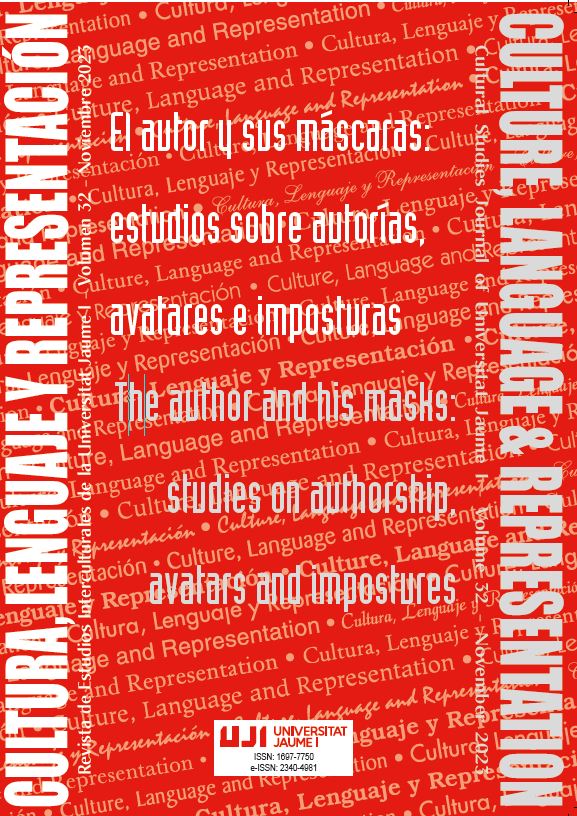La cuestión de la autoría en las nivolas de Miguel de Unamuno
Contenido principal del artículo
Resumen
El presente artículo propone un estudio sobre las formas en las que Unamuno concibe la autoría de la nivola y sobre cómo éstas se manifiestan en las distintas nivolas, particularmente en Amor y pedagogía, Niebla, Abel Sánchez y La novela de don Sandalio jugador de ajedrez.
Como novelista y teórico de la novela, Unamuno defiende la autoría compartida por lo que, en la nivola, empleará las estrategias narrativas necesarias para eliminarse como autor de la misma. De entre los procedimientos más recurrentes, cabe destacar la ficcionalización de Unamuno mediante tres estrategias: el empleo de una entidad ficcional como autor de la nivola, la desidentificación unamuniana mediante, entre otros, la metalepsis, y su desacreditación como autor de la nivola en el interior de la misma. En paralelo, Unamuno, en su dimensión ontológica, como filósofo y pensador, lucha contra la finitud del ser humano mediante el procedimiento al que hemos denominado «la mascarada» de Unamuno, que le permite prevaler en su obra. Esta mascarada consiste en la delegación de su discurso a diferentes personajes. Proceso que puede llevarse a cabo de forma parcial (lo cual se ha calificado de «máscara simple») o de forma compleja (a la que corresponden los agonistas y los alter egos unamunianos).
Con este trabajo se identificarán cada una de las estrategias mencionadas en la narrativa unamuniana con el fin de fomentar el debate sobre la cohabitación de dos formas de entender la autoría, a priori opuestas entre sí.
Descargas
Detalles del artículo
Se utiliza una licencia de derechos de autor CREATIVE COMMONS de acceso abierto.
Aquellos autores/as cuyos trabajos sean publicados por esta revista esta revista, aceptan los términos siguientes:
Concretamente mediante las siguientes acciones:
- - Los autores/as conservarán sus derechos de autor y garantizarán a la revista el derecho de primera publicación de su obra, el cuál estará simultáneamente sujeto a la Licencia de reconocimiento de Creative Commons CC BY SA que permite a terceros compartir la obra siempre que se indique su autor y su primera publicación esta revista.
- - Cumplimiento de un porcentaje mínimo del 40% de mujeres como revisoras de los trabajos enviados a la revista.
- - Los autores/as conservarán sus derechos de autor y garantizarán a la revista el derecho de primera publicación de su obra, el cuál estará simultáneamente sujeto a la Licencia de reconocimiento de Creative Commons CC BY SA que permite a terceros compartir la obra siempre que se indique su autor y su primera publicación esta revista.
- - Los autores/as podrán adoptar otros acuerdos de licencia no exclusiva de distribución de la versión de la obra publicada (p. ej.: depositarla en un archivo telemático institucional o publicarla en un volumen monográfico) siempre que se indique la publicación inicial en esta revista.
- - Se permite y recomienda a los autores/as difundir su obra a través de Internet (p. ej.: en archivos telemáticos institucionales o en su página web) antes y durante el proceso de envío, lo cual puede producir intercambios interesantes y aumentar las citas de la obra publicada.
Citas
Bajtín, Mijaíl. 1989. Teoría y Estética de la novela. Trad. Helena S. Kriúkova y Vicente Cazcarra. Colección “Teoría y crítica literaria”. Dir. Darío Villanueva. Madrid: Taurus.
Bajtín, Mijaíl. (1933/2005). La cultura popular en la Edad Media y en el Renacimiento. El contexto de François Rabelais. Madrid: Alianza editorial.
Barthes, Roland. 1984. «La mort de l’auteur». Le Bruissement de la langue: Essais critiques IV. Colección Points. Paris: Seuil 61–67.
Derrida, Jacques. La diseminación. Trad. De José María Arancibia. España: Espiral, 2007.
Ducrot, Oswald. 1984. Le dire et le dit. Colección Propositions. Paris : Minuit.
Genette, Gérard. 2004. Métalepse: de la figure à la fiction. Colección Poétique. Paris : Seuil.
Jouve, Vincent. 2010. Poétique du roman. Paris: Armand Colin.
Kristeva, Julia. 1969. Séméiotikè. Recherches pour une sémanalyse. Colección Points. Paris : Seuil.
Unamuno, Miguel de. 2020. Del sentimiento trágico de la vida (1912). Colección “De bolsillo”. Madrid: Alianza editorial.
Unamuno, Miguel de. 2018. Teresa (1924). Colección Letras hispánicas. Ed. Mº Consuelo Belda Vázquez. Madrid: Cátedra.
Unamuno, Miguel de. 2005a. Narrativa completa I. Amor y pedagogía (1902). Barcelona: RBA- Instituto Cervantes.
Unamuno, Miguel de. 2005a. Narrativa completa I. Niebla (1914). Barcelona: RBA- Instituto Cervantes.
Unamuno, Miguel de. 2005a. Narrativa completa I. Abel Sánchez (1917). Barcelona: RBA- Instituto Cervantes.
Unamuno, Miguel de. 2005b. Narrativa completa II. La novela de don Sandalio jugador de ajedrez (1930,1933). Barcelona: RBA- Instituto Cervantes.
Unamuno, Miguel de. 1958a. «Heráclito, Demócrito y Jeremías» (1915). En Obras completas, t. IX. Novela II y Monodiálogos, ed. Manuel García Blanco. Madrid: Afrodisio Aguado.
Unamuno, Miguel de. 1958b. «Nuestros yos ex-futuros» (Inédit, 1923). En Obras completas, t. X. Autobiografía y recuerdos personales, ed. Manuel García Blanco. Madrid: Afrodisio Aguado.
Shlickers, Sabine. 2005. «Inversion, transgressions, paradoxes et bizarreries. La métalepse dans les littératures espagnoles et française.» En Métalepses. Entorses au pacte de la représentation, dir. John Pier y Jean-Marie Schaeffer. Paris: EHESS, colección « Recherches d’histoire et de sciences sociales », 108 : 151-156.
Todorov, Tzevetan. 1981. Mikkaïl Bakthine. Le principe dialogique. Colección “Poétique”. París: Seuil.
Vauthier, Bénédicte (ed). 2002. Amor y pedagogía/Epistolario Miguel de Unamuno/Santiago Valentí Camp. Madrid: Biblioteca Nueva.


